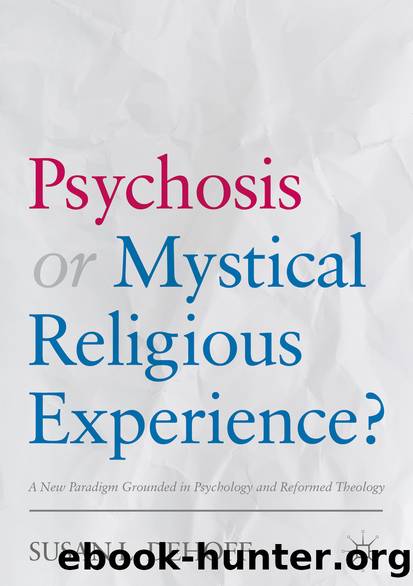Psychosis or Mystical Religious Experience? by Susan L. DeHoff

Author:Susan L. DeHoff
Language: eng
Format: epub
Publisher: Springer International Publishing, Cham
Giovanni Stanghellini gave a summary of self-disturbance, quoting a person with schizophrenia: “I can’t distinguish between thought, imagination, and reality” (2009, p. 314). And Johnson described it metaphorically, writing “I am trying to function on fumes and on a foundation of nothing” (2012, p. 208).
A main feature of self-disturbance is thought disruption. Courtney Humphries described psychosis as “a problem of thinking” (2017, p. 42). Self-disturbance can be seen as the ground out of which delusions, a basic part of the psychotic experience, emerge. Caroline Brett described the delusional mood as one in which “The world may seem strangely insubstantial, or mutable, and bathed in a kind of aura of particularity, meaningfulness, or knowing” (2002, p. 326). She continued, “the frameworks of time, space, substance, and causal interaction, which ordinarily underpin cognition, may all be distorted concurrently” (ibid., p. 327). What is “reality” becomes murky. Brett noted that the person experiencing psychosis experiences a turning inward of consciousness, so that what is experienced is the experience itself and not the external world (ibid.). Delusions result from how the meanings of self and world are made, given the cognitive and affective disturbances of psychosis. Narratives reflect that disturbance “when the range of mental activities (e.g. thoughts, feelings, intentions, wishes, plans) are not woven together into a coherent whole” (Mishara et al. 2013, p. 7). P. K. Chadwick (1992) wrote about the “meaning feeling,” describing it as “a feeling of significance, of portentousness, of foreboding, of multiplicity and wispy insubstantial ambiguity” (p. 92). The meaning feeling is devoid of content; the meaning of the experience is in the experience of the feeling itself.
DSM-V, like DSM-IV-TR, lists ten main types of delusions : persecutory, referential, somatic, religious, grandiose, erotomanic, nihilistic, thought withdrawal, thought insertion, and delusions of control (APA 2013, p. 87). Rhodes et al. (2005) found several unresolved issues with the DSM system and argued that a more descriptive approach to conceptualizing delusions would be helpful. They conducted qualitative research that examined delusions without applying a priori preconceptions. Semi-structured interviews were conducted with 25 participants who had experienced long-term delusions. Results suggested 34 themes, with the possibility of several themes, drawn from more than one domain, for any one person (ibid., p. 395) and six content domains: negative self, negative interactions, special self, identity and relationships, specific mental experience, entities (p. 389). Based on this research they concluded that “delusions seem to focus around a few domains of common experience , but the specific themes are very diverse” (ibid., p. 397). The phenomenological approach to psychosis draws attention to the complexity of the problem not only from the standpoint of the individual experiencing delusions but also from the standpoint of professionals seeking to find contours that provide handles with which to grasp psychosis for therapeutic and research purposes.
One aspect of psychotic delusions is magical thinking (Eckblad and Chapman 1983; García-Montes et al. 2014; George and Neufeld 1987; Spitzer et al. 1979). Qualitative research conducted by Spitzer et al. (1979) listed “magical thinking” as one of eight Schizotypal Personality items.
Download
This site does not store any files on its server. We only index and link to content provided by other sites. Please contact the content providers to delete copyright contents if any and email us, we'll remove relevant links or contents immediately.
Should I Stay or Should I Go? by Ramani Durvasula(7518)
Why We Sleep: Unlocking the Power of Sleep and Dreams by Matthew Walker(6557)
Fear by Osho(4619)
Flow by Mihaly Csikszentmihalyi(4579)
Rising Strong by Brene Brown(4342)
Why We Sleep by Matthew Walker(4317)
The Hacking of the American Mind by Robert H. Lustig(4265)
How to Change Your Mind by Michael Pollan(4256)
Too Much and Not the Mood by Durga Chew-Bose(4228)
Lost Connections by Johann Hari(4002)
He's Just Not That Into You by Greg Behrendt & Liz Tuccillo(3806)
Evolve Your Brain by Joe Dispenza(3571)
The Courage to Be Disliked by Ichiro Kishimi & Fumitake Koga(3352)
Crazy Is My Superpower by A.J. Mendez Brooks(3271)
In Cold Blood by Truman Capote(3269)
Resisting Happiness by Matthew Kelly(3265)
What If This Were Enough? by Heather Havrilesky(3250)
The Book of Human Emotions by Tiffany Watt Smith(3198)
Descartes' Error by Antonio Damasio(3188)
